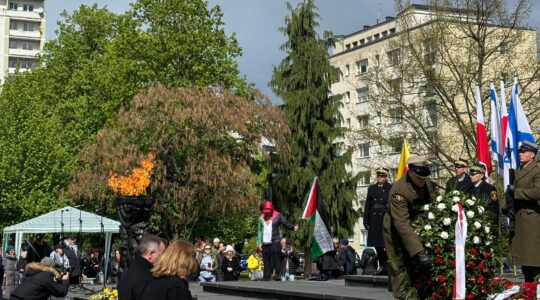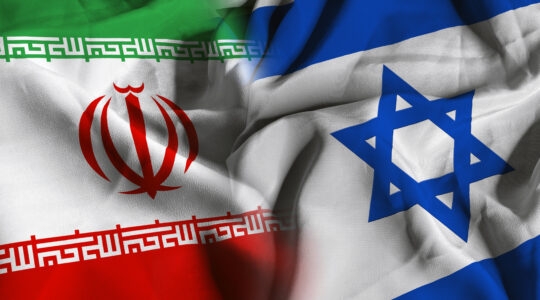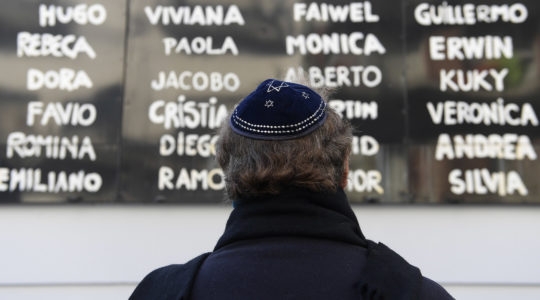The Wandering Jew reports from the annual Party Like a Jew gathering, which attracts young Jews from across Europe for a restful Shabbat followed by a huge Saturday night “ball” at a nearby club. (Ben Harris)
ANTWERP, Belgium (JTA) — It’s a cliche, OK, so sue me. It was also the first thing for sale when I emerged from the bowels of the Brussels train station, having not eaten since a pathetic hotel breakfast in Copenhagen some hours before. And the Belgian waffles were delicious. It didn’t hurt that the sky was blue, the temperature mild, and I had spent nearly two weeks under the unrelentingly gray skies of Denmark and Poland. For a moment, all was right in the world.
I was in Belgium for two reasons.
The European Center for Jewish Students was hosting its annual Brussels weekend, Party Like a Jew, which attracts young Jews from across Europe for a restful Shabbat followed by a huge Saturday night "ball" at a nearby club. Shabbat attracts 400 people, and the number doubles on Saturday night, as partygoers come by car and train from as far as Paris and London just to party like Jews in the Belgian capital.
After that, it was an hourlong train ride to Antwerp, where I’m going to see how the city’s unique Jewish community is faring in the wake of far-reaching changes to the global diamond trade.
‘Party Like a Jew’
Something felt distinct about PLAJ — and it wasn’t only the intense concentration of impossibly high heels and rectangular eyeglasses in shades that would make Tom Daschle blush.
For one, the event was transnational, drawing participants from dozens of countries (though the UK and France seemed to have the strongest contingent. Represent). Several participants said they came mostly to see friends; a number dwarfed only by those who said they were looking for their significant other. In New York, one gets the feeling that everyone has been there before.
In Brussels, everyone — or most everyone — seemed genuinely happy, if not relieved, to be in a comfortable Jewish space. In the States, the opposite is often the case: Being in a Jewish space is a necessary evil, to be endured only in the quest — antiquated, ill understood and yet enduringly strong — to find a Jewish mate. But here people were unabashed about their desire to socialize, and more, with other Jews.
On the way to the Saturday night ball, held in the cavernous and terribly named Event Lounge, the boys on the bus, many already well on their way to hammered, broke into spontaneous choruses of "Am Yisrael Chai" and Chasidic melodies. That would neeeeeeevvver happen back home.
Some of this is probably due to cultural differences between American and European Jews that I’m vaguely beginning to understand. And some is probably due to persistent European anti-Semitism, which to my horror I’m fast discovering may be the best predictor of the intensity of Jewish identification in a given country.
Again I heard stories about the fear of openly wearing Jewish symbols in supposedly liberal, democratic Europe, and the security over the weekend was modest but palpable. I swear, the only physical human contact I experienced amid the lip-locked couples on the dance floor Saturday was the near strip search performed on me and my video equipment by the security guys at the door.
Form and function
The Brussels Central Station is so unremarkable you could miss it. Even inside I wasn’t sure I had found the right place.
Two hours later I was in Antwerp, and the difference couldn’t be starker. Four levels of subterranean platforms emerge into a soaring atrium covering a station built in the typical European style. Above an ornate facade, "Antwerpen" is engraved in gold letters, evoking nothing so much as a cathedral of transportation.
I thought, Brussels is function, Antwerp is form. Whole sections of Brussels, the capital of the European Union, are dominated by the soulless, totemic architecture of the nascent European supra-state. Antwerp is the home of something far more passion-inducing: the diamond trade. One is the capital of bureaucracy, the other of romance.
But the metaphor falls away fast. The narrow tributaries around the station drain into the Jewish quarter, a drab hodgepodge of buildings creeping up on tiny sidewalks. Bearded Chasidim scurry about on bicycles, apparently oblivious to the opposition their comrades in Brooklyn mounted to a bike lane through their neighborhood.
Many of Antwerp’s Jews still derive their income from diamonds, but in defiance of the magnificence of the station, their dwellings betray little of the bling they are responsible for polishing and shipping off to adorn the bodies of the wealthy.
The Jewish presence here is palpable. After spending a weekend with young, mostly secular Jews, seeing so many Jews walking the streets without a second thought is an important corrective. Is there anti-Semitism in Europe? Of course. But Antwerp suggests there’s more to it.
This article was adapted from Ben Harris’ blog (blogs.jta.org/wanderingjew).





